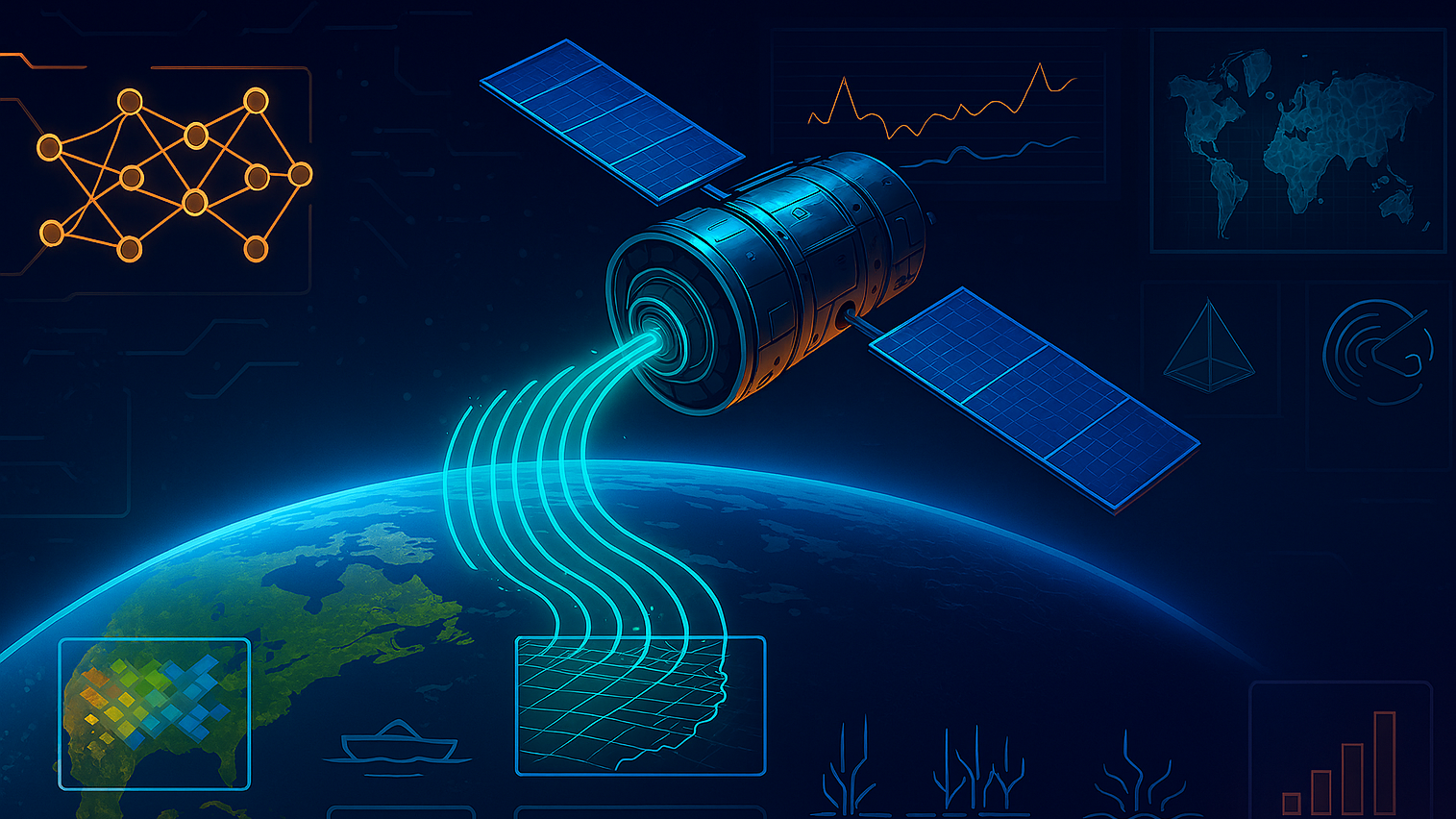Listen to the Podcast
Transforming Remote Sensing Through AI
Artificial Intelligence (AI), particularly deep learning, is revolutionizing remote sensing by dramatically improving data processing capabilities. Convolutional Neural Networks (CNNs) and other neural architectures enable automated feature extraction from satellite and aerial imagery, enhancing land cover classification, object detection, and change detection. These advancements minimize manual effort while significantly increasing accuracy and efficiency.
Deep learning models analyze images by identifying textures, edges, and spectral variations, detecting subtle anomalies that traditional methods might overlook. The availability of large training datasets and powerful computational resources, such as GPUs, has further accelerated progress. AI-based systems now support real-time monitoring, identifying objects such as ships in harbors or vehicles on highways with unprecedented speed and accuracy.
Ongoing research continues to refine these AI techniques. For example, Fraunhofer IOSB has developed an Area-Rescoring Mask technique to reduce double counting in object detection. Such refinements enhance the precision of AI-driven classification and detection, making them indispensable for processing the vast and growing volume of Earth observation (EO) data.
AI-Driven Data Fusion: Unlocking New Information Layers
AI is enabling the integration of multiple remote sensing data sources, uncovering insights that were previously inaccessible. Satellites capture data using diverse sensors, including multispectral optical sensors, synthetic aperture radar (SAR), hyperspectral cameras, and LiDAR systems. AI models can process these datasets collectively, revealing complementary information that single-source analyses cannot achieve.
For example, combining optical imagery with SAR data enhances land cover classification by compensating for cloud interference in optical images. Similarly, LiDAR-derived elevation models integrated with spectral data improve assessments of forest biomass and urban structures. AI-driven data fusion also facilitates time-series analysis, allowing for the detection of trends such as seasonal vegetation cycles or groundwater depletion.
New computational solutions, such as intelligent geospatial databases (e.g., Datacubes), offer efficient storage and retrieval mechanisms for large EO datasets. Another breakthrough is onboard satellite processing, where AI algorithms analyze data in orbit before transmission. The ESA Phi-Sat-1 mission, which uses AI for onboard cloud detection, exemplifies this approach. Future AI-powered satellites may autonomously identify environmental changes and transmit only relevant findings, reducing bandwidth demands and improving real-time responsiveness.
Expanding Applications of AI in Remote Sensing
Advancements in AI and remote sensing are driving innovation in key sectors, including environmental monitoring, agriculture, disaster management, and urban planning. AI-based models are enhancing climate studies, precision farming, emergency response, and sustainable city development.
Environmental Monitoring and Climate Science
AI supports continuous monitoring of Earth’s ecosystems by detecting land cover changes (e.g., deforestation, urban expansion) and tracking climate indicators such as glacier retreat and sea surface temperature fluctuations. By integrating EO data with climate models, AI enhances weather forecasting and improves predictions of extreme events like hurricanes and droughts. Additionally, AI applications assist in monitoring water resources, pollution levels, and air quality in real time.
Agriculture and Food Security
AI-powered precision agriculture enables farmers to make data-driven decisions using satellite and drone imagery. Machine learning models analyze soil moisture, crop health, and pest infestations, optimizing irrigation and fertilization strategies. AI-driven spectral analysis detects plant stress indicators before visible damage occurs, helping to increase crop yields and improve sustainability in food production.
Disaster Prevention and Management
AI improves natural disaster forecasting and emergency response by analyzing historical EO data for early-warning signals of wildfires, landslides, and floods. AI-driven satellite monitoring provides real-time flood maps, damage assessments, and population impact analysis, aiding first responders in crisis situations. These capabilities enhance resource allocation and disaster management efficiency.
Urban Planning and Smart Cities
AI-driven analysis of high-resolution satellite imagery facilitates automated mapping of urban structures, transportation networks, and green spaces. AI helps track urban expansion and assess environmental impacts, such as the heat island effect in cities. Geospatial AI contributes to infrastructure planning, traffic optimization, and sustainable urban development, playing a vital role in shaping smart cities.
Future Trends and Developments (Next 10–20 Years)
AI is set to become a core component of remote sensing in the coming decades. The increasing volume of EO data—generated by missions like ESA’s Sentinel satellites—demands advanced AI-driven processing techniques. Future developments will likely include fully autonomous AI-driven analysis, where satellites act as intelligent sensors, processing and transmitting only the most essential insights.
Advances in AI Algorithms
Future AI models will be more adaptive and robust, integrating physics-based constraints for enhanced accuracy. Explainable AI (XAI) will improve transparency, making AI-driven analyses more interpretable and trustworthy—critical for high-stakes applications like disaster response and environmental monitoring. Additionally, advances in self-supervised learning will enable AI models to extract insights from unlabeled data, reducing reliance on manually annotated datasets.
Operational Shifts and Broader Accessibility
AI-powered remote sensing services will become more user-friendly and widely available. Applications will span from global climate early-warning systems to localized urban planning tools. Decision-makers will interact with real-time AI-processed EO imagery, simulating various scenarios (e.g., assessing the impact of new infrastructure on air quality and traffic patterns). The vision of a “digital twin of Earth”, continuously updated with AI-enhanced data, is rapidly becoming a reality.
Challenges and Ethical Considerations
Despite its potential, AI-driven remote sensing faces several challenges. Ensuring data reliability, reducing biases, and addressing ethical concerns will be crucial. Additionally, advances in federated learning—where AI models are trained across decentralized data sources—could enhance privacy while improving model performance. Nonetheless, the trajectory is clear: AI is revolutionizing remote sensing, enabling faster, more precise, and deeper insights into our planet.
Conclusion
Over the next 10–20 years, AI will evolve from a powerful analytical tool into an autonomous system that drives global environmental decision-making. From climate resilience to disaster management and urban development, AI-powered remote sensing will play a pivotal role in shaping a sustainable future.
Expand Your Knowledge – Dive Deeper
– Earth Observation – Disruptive Technology and New Space
Further Reading
- Adegun, A. A., Viriri, S., & Tapamo, J. R. (2023). Review of deep learning methods for remote sensing satellite images classification: experimental survey and comparative analysis. Journal of Big Data, 10(1), 93.
- Hao, M., Dong, X., Jiang, D., Yu, X., Ding, F., & Zhuo, J. (2024). Land-use classification based on high-resolution remote sensing imagery and deep learning models. Plos one, 19(4), e0300473.
- Shafique, A., Cao, G., Khan, Z., Asad, M., & Aslam, M. (2022). Deep learning-based change detection in remote sensing images: A review. Remote Sensing, 14(4), 871.
- Li, J., Hong, D., Gao, L., Yao, J., Zheng, K., Zhang, B., & Chanussot, J. (2022). Deep learning in multimodal remote sensing data fusion: A comprehensive review. International Journal of Applied Earth Observation and Geoinformation, 112, 102926.
- Höhl, A., Obadic, I., Torres, M. Á. F., Najjar, H., Oliveira, D., Akata, Z., … & Zhu, X. X. Opening the Black-Box: A Systematic Review on Explainable AI in Remote Sensing. arXiv 2024. arXiv preprint arXiv:2402.1379.
- Muhtar, D., Zhang, X., Xiao, P., Li, Z., & Gu, F. (2023). Cmid: A unified self-supervised learning framework for remote sensing image understanding. IEEE Transactions on Geoscience and Remote Sensing, 61, 1-17.
- Janga, B., Asamani, G. P., Sun, Z., & Cristea, N. (2023). A review of practical ai for remote sensing in earth sciences. Remote Sensing, 15(16), 4112.



Nicely explained! The Future of Remote Sensing with AI